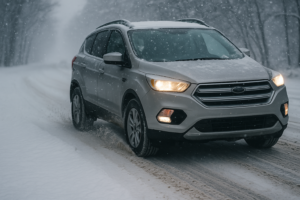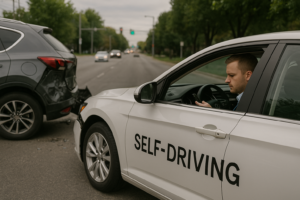Not Every Accident Is Caused by a Driver Sometimes the Car Itself Is at Fault
When we purchase vehicles, we expect manufacturers to design and build them safely. Unfortunately, that’s not always the case. Manufacturers sometimes rush vehicles to market before completing proper testing, design them poorly, or use components known to fail at crucial moments. While 94% of serious crashes are attributed to driver error, the remaining percentage, often overlooked, includes cases where faulty vehicle design or manufacturing is to blame.
Critical Reasons for Motor Vehicle Crashes
Attributed to Drivers, Vehicles, and Environment
(Source: National Motor Vehicle Crash Causation Survey, NHTSA 2005–2007)
Critical Reason Attributed To | Estimated Number | Estimated Percentage<br>± 95% Confidence Limits |
Drivers | 2,046,000 | 94% ± 2.2% |
Vehicles | 44,000 | 2% ± 0.7% |
Environment | 52,000 | 2% ± 1.3% |
Unknown Critical Reasons | 47,000 | 2% ± 1.4% |
Total | 2,189,000 | 100% |
Check Your Vehicle for Safety Recalls
If you suspect a vehicle defect may have caused your accident or are simply concerned about your vehicle’s safety, it’s essential to check for any active recalls. Recalls are issued when manufacturers or federal agencies like the National Highway Traffic Safety Administration (NHTSA) identify defects that could compromise your safety, including faulty airbags, brakes, ignition systems, or tires. To see if your vehicle has an open recall, visit the official NHTSA recall lookup tool
If your accident involved a malfunctioning vehicle, you may have a case against the manufacturer, and not even know it.
Legal Basis for Manufacturer Liability
Product liability law protects consumers from unsafe vehicles and provides the foundation for holding car manufacturers accountable. Under these laws, manufacturers have a legal obligation to produce safe vehicles and can face serious consequences when they fail to do so.
Car manufacturers can be held liable under product liability if:
- The vehicle or part was defectively designed
- It was manufactured improperly
- It was sold without adequate warnings or instructions
These cases typically proceed under three key legal theories:
- Negligence: The manufacturer failed to uphold their duty of care in designing, manufacturing, or testing their vehicles.
- Strict Liability: You don’t need to prove negligence, only that a defective product caused your injuries and damages. This approach is available in most states, making it easier for victims to recover damages without the difficult task of proving manufacturer negligence.
Breach of Warranty: The manufacturer violated implied or express warranties about the vehicle’s safety and performance.
Common Types of Defects That Lead to Manufacturer Liability
Design Defects
Design defects occur when a vehicle is inherently dangerous even when manufactured correctly and used as intended. These flaws exist in the fundamental blueprint of the vehicle, making every unit potentially dangerous. Examples include SUVs with high rollover risks, poorly designed fuel systems vulnerable to rupture during collisions, or unstable vehicle structures.
Manufacturing Defects
Manufacturing defects happen during production when something goes wrong with an individual vehicle or component. Unlike design flaws, these typically affect a limited number of vehicles rather than an entire model line. Examples include missing structural bolts, improperly installed brakes, defective airbag inflators (like in the massive Takata recall), or substandard materials that fail to meet specifications.
Failure to Warn or Instruct
Sometimes called failure to warn, these defects occur when manufacturers don’t adequately disclose inherent dangers or provide proper instructions for safe vehicle operation. Example: A car seat manufacturer failing to advise users on correct harness adjustments for newborns, or tire manufacturers not providing guidance on safe pressure limits and replacement schedules.
Table Vehicle-Related Causes of Crashes
(Estimated from 2% of NMVCCS Crashes)
Source: National Motor Vehicle Crash Causation Survey, NHTSA 2005–2007
Critical Reason | Estimated Number | Estimated Percentage<br>± 95% Confidence Limits |
Tires / wheels-related | 15,000 | 35% ± 11.4% |
Brakes-related | 10,000 | 22% ± 15.4% |
Steering/suspension/transmission/engine-related | 2,000 | 3% ± 3.3% |
Other / unknown vehicle-related problems | 17,000 | 40% ± 24.0% |
Total | 44,000 | 100% |
Signs a Manufacturer May Be at Fault
Several indicators suggest a vehicle defect might have contributed to your accident:
- You lost control of the vehicle without apparent cause
- Safety features like airbags, seatbelts, or anti-lock brakes failed during the crash
- Multiple vehicles of the same make and model are under recall
- Expert analysis reveals the vehicle had a mechanical or electronic malfunction
- The vehicle behaved unpredictably despite normal operation
Always preserve the vehicle for a post-accident inspection if a defect is suspected. This physical evidence is crucial for building a strong product liability case.
Real-World Examples of Manufacturer Liability
Vehicle defects have led to some of the largest recalls and legal settlements in consumer history:
- Takata Airbag Recall: Defective airbag inflators could explode upon deployment, sending metal fragments into vehicle occupants and causing severe injuries and deaths.
- Toyota Sudden Acceleration Cases: Alleged electronic throttle control defects caused vehicles to accelerate unintentionally, leading to accidents, injuries, and fatalities.
- GM Ignition Switch Defect: Faulty ignition switches could shut off engines while driving, disabling power steering, brakes, and airbags, resulting in numerous crashes and deaths.
- Ford-Firestone Tire Controversy: Tire tread separation on Ford Explorers led to deadly rollover accidents and one of the most publicized safety defect cases in automotive history.
These high-profile cases highlight how manufacturer negligence can have deadly consequences, and how legal action can drive safety reform across the industry.
How to Prove a Manufacturer's Fault in an Accident
Building a successful case against a vehicle manufacturer requires specialized expertise and resources:
- Secure the vehicle as evidence: Never repair or dispose of the vehicle before consulting with an attorney, as the physical evidence is critical.
- Conduct a mechanical inspection with certified experts: Expert analysis can identify defects that aren’t immediately apparent.
- Collect recall notices, service history, and manufacturer warnings: These documents can demonstrate the manufacturer was aware of potential issues.
- Work with a product liability attorney: Experienced lawyers can access internal design and manufacturing data that may reveal known problems.
Manufacturers have teams of lawyers, having the right legal support is essential for navigating these complex cases.
Compensation Available in Product Liability Cases
Victims of accidents caused by vehicle defects may be entitled to recover:
- Medical expenses: Both immediate and long-term healthcare costs related to your injuries
- Lost income and earning capacity: Compensation for missed work and reduced ability to earn in the future
- Pain and suffering: For physical pain and emotional distress caused by the accident
- Property damage: Costs to repair or replace your vehicle and other damaged property
- Punitive damages: Additional compensation in cases where manufacturers showed gross negligence or attempted to cover up known defects
When to Contact a Lawyer
You should consult with an experienced product liability attorney if:
- Your vehicle malfunctioned right before or during a crash
- You’ve been contacted about a recall after your accident
- You suspect that a defective part contributed to your injuries or someone else’s death
- Insurance companies refuse to investigate the possibility of a product defect
(FAQ) Frequently Asked Questions
Can I sue both the driver and the manufacturer?
Yes. If both parties contributed to the crash, you may be able to pursue claims against both the other driver for negligent operation and the manufacturer for the defective vehicle.
What if the car was already under recall?
If you weren’t properly notified of the recall or the recall repair failed, the manufacturer may still be liable. In fact, a pre-existing recall can strengthen your case by establishing the manufacturer’s knowledge of the defect.
Is there a time limit to file a claim?
Yes. Each state has a statute of limitations, typically 2 to 4 years for product liability cases. It’s crucial to consult with an attorney as soon as possible after an accident to preserve your legal rights.
Who besides the manufacturer can be held liable?
Multiple parties may share responsibility in a defective vehicle case, including:
- Parts manufacturers that produced the defective component
- Car dealerships that sold the vehicle
- Distributors and suppliers in the vehicle’s supply chain
- Automotive repair shops that improperly installed or maintained components
What if I was partially at fault for the accident?
Many states allow for shared fault under comparative negligence rules. You may still recover compensation, though the amount may be reduced by your share of fault. An experienced attorney can help maximize your recovery even in complicated liability scenarios.
Can leased or used car owners file a defect claim?
Yes, product liability applies regardless of whether you bought the vehicle new, used, or leased, so long as the defect existed when it left the manufacturer. Second-hand owners have the same rights to pursue compensation for injuries caused by defective vehicles.



